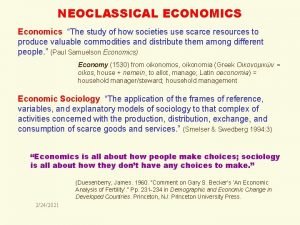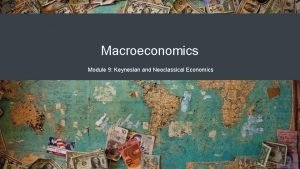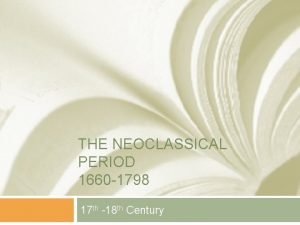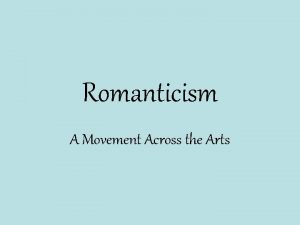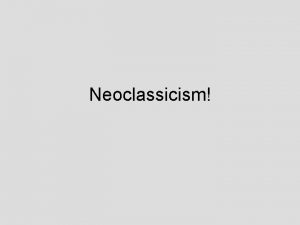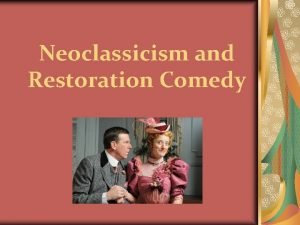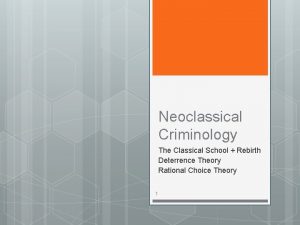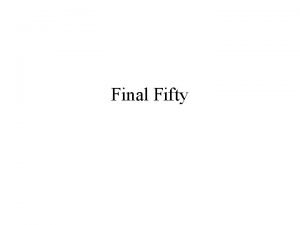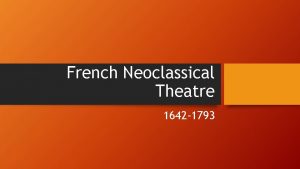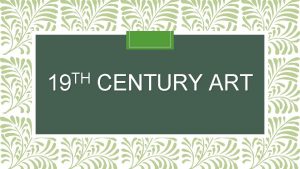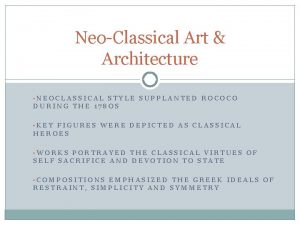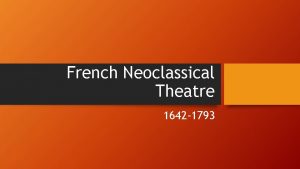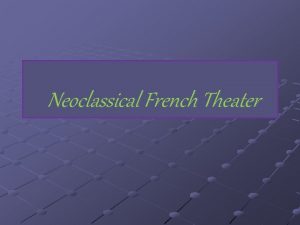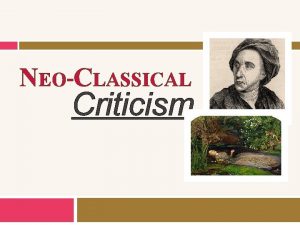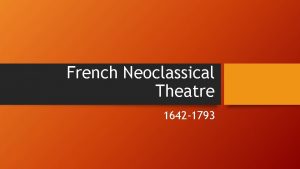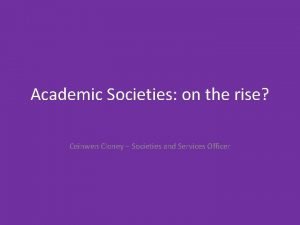NEOCLASSICAL ECONOMICS Economics The study of how societies











- Slides: 11

NEOCLASSICAL ECONOMICS Economics “The study of how societies use scarce resources to produce valuable commodities and distribute them among different people. ” (Paul Samuelson Economics) Economy (1530) from oikonomos, oikonomia (Greek Οικονομικών = oikos, house + nemein, to allot, manage; Latin oeconomia) = household manager/steward; household management Economic Sociology “The application of the frames of reference, variables, and explanatory models of sociology to that complex of activities concerned with the production, distribution, exchange, and consumption of scarce goods and services. ” (Smelser & Swedberg 1994: 3) “Economics is all about how people make choices; sociology is all about how they don’t have any choices to make. ” (Duesenberry, James. 1960. “Comment on Gary S. Becker’s ‘An Economic Analysis of Fertility’. ” Pp. 231 -234 in Demographic and Economic Change in Developed Countries. Princeton, NJ: Princeton University Press. 2/24/2021

Marginal Analysis Classical economics – created by Adam Smith (The Wealth of Nations, 1776), David Ricardo, John Stuart Mills – stressed the benefits of free trade, market tendency to equilibrium, and a labor theory of value. Prices objectively reflect the amount of labor required to produce goods. This assumption is the basis of Marx’s theory of capitalist exploitation of workers. A. Smith Marginal utility theory dominated neoclassical economics after 1870. Marginal utilitydf = added subjective satisfaction or benefit that a consumer derives from an additional unit of commodity or service. Utility is inverse to consumption: the price a consumer is willing to pay for additional purchases diminishes due to satiation. EX How much are you willing to pay for your first laptop? How much for a second; third; hundredth? 2/24/2021

Individuals Maximize Utility Neoclassical economists assume methodological individualism: all economic phenomena can be explained by aggregating over individuals’ behaviors. They de-emphasize institutions – rules & regulations that predate and condition an individual’s actions. Consumers and producers are rational actors who seek to maximize subjective expected utility across a set of goods and services, making choices within a budget constraint: e. g. , what Ns of bananas & mangoes for $XX will maximize your SEU? Alfred Marshall (1890) analyzed commodity prices and production quantities as the intersection between supply and demand curves: ► Consumer utility maximization explains shifts in the supply & demand curves for consumer goods. 2/24/2021 A. Marshall ► Producer profit maximization explains the origin of firms’ demand curves for factors of production, and underlies neoclassical economics’ theory of the firm.

Factors of Production Land Labor Firm production function Technological constraints Business Buyers 2/24/2021 Capital $ Goods & services for sale in the market Budgetary constraints $ Consumer Buyers

Firms Maximize Profits The core neoclassical assumption: Firm goal ≡ profit maximization Profit maximization is the process by which a firm determines the price and output levels that will return its largest profit. Marginal analysis reveals that profit maximization requires reducing total cost relative to total revenue: Revenue = Price of product X Quantity sold Cost = Price of inputs X Quantity used Profit = Revenue – Cost To maximize its profit in a perfectly competitive market (where all firms are price-takers, not price-makers), a firm should produce output until its marginal cost of producing the last unit exactly equals the equilibirum price in the market, at which every firm sells all the units they produce. General equilibria are the aggregate solutions to individual maximization problems. 2/24/2021 (See next slide)

Finding the Maximum Profit The Market $ D The Firm $ S PE MC AC PE Q QEQUILIBRIUM Q QPRODUCED Market price for a good & the quantity produced by all firms is determined at equilibrium by the intersection between: Firm produces the product until its marginal cost of producing the last unit equals the market price. Its profit is the difference between: (a) downward sloping consumer demand curve D; and 2/24/2021 (b) upward sloping producer supply curve S. (a) total revenue ( = Q x P) minus (b) total cost ( = Q x Average Cost)

Market Transactions Economics claims that the market, through its pricing mechanism, is the most efficient means to coordinate all buy-sell transactions. • Producers and consumers are rational actors, assumed to have perfect information about market prices at the time of exchange. • Actors’ abilties to calculate their utility and profit maxima are equal (no information asymmetries). Participation in market transactions doesn’t run a risk of opportunistic behavior (“self-seeking with guile”). Therefore, no transaction costs need occur: • Search costs • Negotiation costs • Organizational costs • Monitoring costs • Opportunity costs 2/24/2021

The Firm as Black Box Neoclassical economists did not theorize about what goes on inside firms. Organizationally, the “production function” is an undifferentiated black box that mysteriously transforms factors of production into products & services for sale on the market. INPUTS OUTPUTS Using the firm’s production function, a single owner/manager decides what & how much will be produced, subject to its budget constraint. Neoclassical theory of the firm ignores the differing interests, resources, and actions of entrepreneurial owners, boards of directors, shareholders, managers, employees, communities, 2/24/2021 governments, and numerous other firm stakeholders.

Criticisms of Neoclassical Economics Neoclassical economics is often criticized for not explaining actual economies, instead describing a normative “Pareto-optimal Utopia" Over-Reaching Claims (a. k. a. economic imperialism): “The economic approach is a comprehensive one that is applicable to all human behavior – all human behavior can be viewed as involving participants who maximize their utility from a stable set of preferences and accumulate an optimal amount of information. ” (Gary S. Becker 1976 The Economic Approach to Human Behavior). Unrealistic Assumptions -- Do these principles reflect a real world? • People & orgs are rational, risk-neutral, self-interested utility maximizers • Humans possess perfect information (certainty) about prices & qualities • Production, profit, efficiency, … are the only important economic values • Markets are perfectly competitive (participants are price-takers, not -makers) • Economies can use unlimited planetary resources, no externalities (pollution) • Simplification to obtain (mathematical) rigor is analytically worthwhile 2/24/2021

Economic Sociology as Alternative Economic sociology in its classical era emphasized institutional analysis “Economic sociology is the study of “economic institutions. ” (Joseph Schumpeter. 1954. History of Economic Analysis). “Finally there are the economic institutions: institutions relating to the production of wealth (serfdom, tenant farming, corporate organization, production in factories, in mills, at home, and so on), institutions relating to exchange (commercial organization, markets, stock exchanges, and so on), institutions relating to distribution (rent, interest, salaries, and so on). They form the subject matter of economic sociology. ” (Emile Durkheim. 1909. L'Année Sociologique. ) Central concepts in economic sociology’s current era are social embeddedness and the social construction of economic institutions THREE THEORETICAL PILLARS of ECON SOC: ► Networks – embeddedness of interpersonal & interorganizational relations ► Organizations – resource dependence, neoinstitutionalism, pop. ecology, … ► 2/24/2021 Culture – beliefs, ideologies, taken-for-granted assumptions

Readings Discussion Quex 1. How valid are Becker & Coleman claims that utility-maximizing principles can explain all forms of social behavior, not just economic activities? 2. By going beyond narrow self-interest to include other motives (guilt, affection), has Becker diluted neoclassical econ model’s rigor & power? 3. How can social structure & action perspectives enrich economics? Or is Fine right: economics’ colonization of social sciences is inevitable? 4. Why does Granovetter call embeddedness “the opposite of atomization”? Does this structural approach to economic life make econ soc distinct from economics? Or can econ soc deal only with nonrational “left-overs”? 5. Is Swedberg’s theoretical tripod sufficient for developing econ soc as an intellectually powerful & institutionalized theory group? Don’t middle-range theories lack the unifying power achieved by neoclassical economics? 6. What does Zafirovski see as relation between econ soc & economics? Why does he argue that rational choice model is unable to bridge the gap? 7. Beckert argues that refuting maximization alone can’t create a truly sociological theory of economics. How could uncertainty about outcomes become the foundation of an alternative to neoclassical economics? 2/24/2021
 Neoclassical economics
Neoclassical economics Economics keynesian vs classical
Economics keynesian vs classical Neoclassical period literature
Neoclassical period literature Romanticism art vs neoclassicism
Romanticism art vs neoclassicism Metaphysical and cavalier poets
Metaphysical and cavalier poets 5 characteristics of neoclassicism
5 characteristics of neoclassicism Comedy of manners or restoration comedy
Comedy of manners or restoration comedy Difference between classical theory and neoclassical theory
Difference between classical theory and neoclassical theory Neoclassical theory criminology
Neoclassical theory criminology Neoclassical (1750–1850)
Neoclassical (1750–1850) Composition with red, yellow, blue, and black
Composition with red, yellow, blue, and black Napoleon crossing the alps neoclassical or romantic
Napoleon crossing the alps neoclassical or romantic
